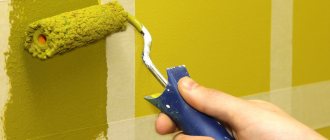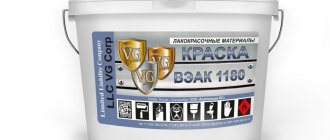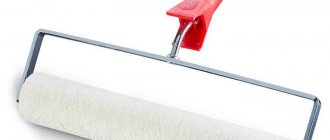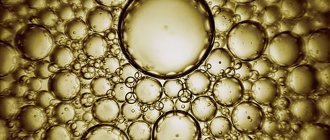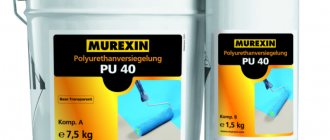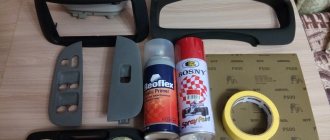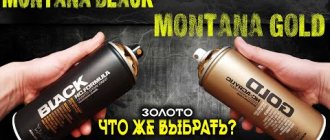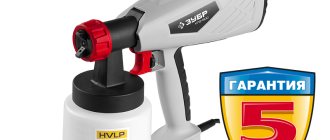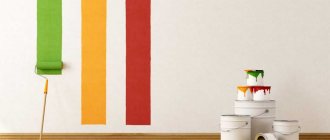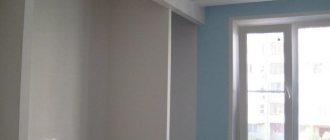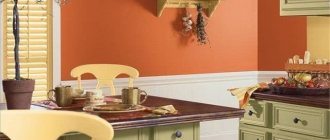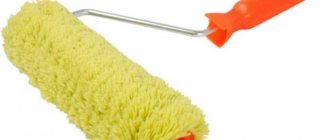Types of sprayers
When choosing the type of tool, it is necessary to take into account the area of the surface to be processed. Powerful pneumatic or electric spray guns for water-based paint are more often used by professional painters for large volumes of work. Piston hand sprayers are more suitable for home use.
Manual (mechanical)
Inexpensive tools with a simple design look like old-style car pumps. The paint is pumped into them using a piston driven manually. The simplest manual paint sprayer consists of the following parts and components:
- housing in the form of a cylinder, inside of which there are 2 valves, the first for air injection, the second for paint intake;
- a piston pump enclosed in a cylinder;
- handles in the form of the letter “T” for manual air injection;
- a spray gun (gun) with a trigger, to which 2 hoses are connected: a pressure hose that supplies compressed air, and a suction hose for taking in paint; the latter is equipped with a filter to retain solid particles;
- paint tank;
- fishing rods with adjustable length to which the sprayer is attached.
This spray gun is quite suitable for water-based acrylic paint. To adjust the supply of solution, a special screw is provided on the needle valve of the sprayer. You will have to get used to such a tool. The pumping speed and jet strength will have to be determined experimentally.
Electrical
Their power may vary. Portable compact devices have minimal weight and low performance. The weight of the device without paint is only 1.4-2.5 kg.
The air is pumped into them not manually, but using an electric pump. The rotating head of the spray gun has been replaced with a nozzle. Paint sprayers for water-based paint with a built-in capacity of 0.6-1.3 liters are used for work at home. More powerful models with a capacity of 240-250 sq. m per hour are equipped with remote pumps and hoses for connecting tanks. The disadvantages include increased noise during operation.
A type of electric sprayers are plunger devices. The emulsion in them is pushed out not with the help of air masses, but with the help of a piston (plunger). They are very economical. Paint consumption when using such units is minimal. And there is minimal “fog” generated during work. Plus, the paint can be taken directly from the bucket through a hose. However, the quality of painting is worse than using conventional air spray guns.
Separately, we can highlight battery-powered models with a 1-2 liter tank, which outwardly resemble screwdrivers. They are similar in design to electric ones. But the electric pump is started not from the mains, but using a battery.
Inexpensive devices with a power of up to 500 W are classified as household devices. However, the quality of painting is worse - the layer is not very uniform. Such models are not suitable for thick and viscous compositions. And the paint tank attached to the gun is not very convenient - the center of gravity in them is shifted. It is better if it is located below.
Pneumatic
Now let’s figure out which spray gun is better: air or airless. It is believed that semi-automatic devices, in which air is pumped using a pneumatic compressor, provide the best quality of painting. The paint is distributed in a thin layer, evenly. Their performance is also impressive. It can be up to 400 sq. m.
A pneumatic spray gun for water-based paint can be equipped with a built-in or external tank connected via a hose. Its capacity in the latter case increases significantly from 25 to 600 liters. Such units are more suitable for professional work. For use at home, a tank of 24-50 liters is sufficient. The average power of pneumatic devices is 0.7-3 kW. The most popular are devices with a capacity of 1.2-1.8 kW.
Types of spray guns
There are three types of water emulsion sprayers: an electric unit, a device with a compressor, and a simple mechanical (i.e., manual) device. Let's look at each of them in more detail.
Electric
There is a thick water-based emulsion on sale, which forces you to pay attention to the size of the spray nozzle. At the preliminary stage, the composition must be diluted. The thickness of the layer and the quality of painting are affected by pressure. With low pressure and a shallow outlet, paint particles will get stuck in the sprayer, which will negatively affect the result. Devices capable of delivering water-based paint under high pressure cost more.
Please note: Is it possible to apply water-based paint to oil-based paint?
A common painting method is airless. An example of a device operating on this principle is the Fiolent KR1-260 spray gun. The device can spray paint with a viscosity of 80 din. The productivity of Fiolent is 260 ml, i.e. This is how much liquid is sprayed in one minute. The power of the device is 60 W, and the comfortable handle ensures that the sprayer is fixed in the hands of the worker.
A trusted brand is an electric spray gun for water-based paint from the Bosch brand (model PFS 2000). The tool has increased power (440 W) and is suitable for spraying not only water-based emulsion, but also varnish or oil impregnation. The flow of liquid supplied is regulated by the worker, so if the instructions are followed, streaks and splashes are eliminated.
Electric spray gun
Pneumatic
A pneumatic spray gun is suitable for spraying water-based paints; it can also be used to paint surfaces using other types of paints. If we are talking about a professional sprayer, then in one hour the device can paint up to 400 squares. Pneumatic spray guns are more expensive than electric and manual versions of the device.
The pneumatic unit is based on a compressor unit that creates compressed air. After mixing with paint, spraying occurs. Moreover, surfaces can be processed with different power. The type of spray design can be aimed at both professionals and beginners.
The preliminary stage involves checking the functionality of the device with water. Such a test will help you get used to it in order to achieve thorough staining in future work. Paint sprayers with the designation HVLP (the abbreviation can be translated as “high volume combined with low pressure”) paint surfaces with any paintwork materials. Structurally, the device is designed so that at the inlet to the gun the pressure is not as high as in the air cap of a pneumatic sprayer. Processing is carried out with a “soft torch”, i.e. fog level is reduced.
Please note: Painting wood with water-based paint: recommendations for surface treatment
Spray guns of the RP type (translated from English as “reduced pressure”) produce a wide spray and the volume of paint supplied for spraying is high. Defects can be avoided if the coloring composition is properly diluted. The air flow required for full operation of the device can reach 430 liters per minute. This volume allows you to reduce working time, and the finishing layer is thin, which corresponds to extra-class.
Pneumatic spray gun
Mechanical manual
A hand-held spray gun for water-based paint is used for small amounts of work. Ceilings and walls in a small apartment can be easily painted with a mechanical sprayer that is not equipped with a compressor unit. The simple design will last a long time, and if parts break, they can be easily replaced with new ones. Expensive models will include units costing up to 4 thousand rubles, simple ones can be found at a price of up to 1 thousand.
The domestic sprayer of the ULIG brand is suitable for treating walls and ceilings with a water-based emulsion, the density of which does not exceed 1.3 g per cubic cm. The metal body is not afraid of mechanical damage (for example, when dropped from a height). The long hose makes it easier to work with the spray wand.
KRDP devices boast similar characteristics. Water-based paint suitable for this type of spray gun should not have a viscosity of more than 20 din. The peculiarity of the device is that even at a height of up to 3.5 m, painting will be successful without organizing high-rise structures. In one hour, the sprayer can process up to 150 squares. In accordance with the instructions, at the preliminary stage the cylinder and cuff must be treated with machine oil. Leaks are checked with plain water. The ball valve regulates the paint flow, so constant trigger operation is not required.
Mechanical hand spray gun
What characteristics should you pay special attention to?
Regardless of the design and spraying method, a high-quality electric, pneumatic or manual spray gun for water-based paint must meet the following requirements:
- be light and as comfortable as possible; the center of gravity should be located in such a way that the tool can be held in the hand for a long time without visible strain;
- the sprayer can be turned easily, without effort, so that the painter has the opportunity to quickly change the direction of the jet;
- press the trigger gently, with little resistance;
- the working components of the tool (nozzle and locking needle) are made of wear-resistant materials with anti-corrosion properties; the ideal option is devices with an aluminum body and nickel coating or a stainless steel and brass body;
- since water-based emulsion is a viscous paint, the size of the nozzle must be sufficient for its passage;
- a pneumatic paint sprayer with a bottom tank will cost less, but it is not very convenient to use; so that it does not “spit” the solution, it will always have to be held vertically;
- It is desirable that the sprayer be equipped with Teflon gaskets; they will last much longer than conventional rubberized ones;
- the thickness and viscosity of the water emulsion can be different, so the size of the nozzle must be adjusted; optimal diameter 1.4-1.7 mm; to apply putty you will need removable 6-7 mm nozzles;
- The spray gun should be easy to disassemble and assemble for washing.
When purchasing a sprayer, it is better to choose models from well-known manufacturers. The best spray guns for painting walls and ceilings are products from Hammer, Bosch, Wagner Projectpro, Aspro. Russian manufacturers also have good products: Patriot, Caliber, Fiolent, Zubr.
The quality of spraying largely depends on the shape of the nozzles and needles and their diameter. They can only be checked at work. Therefore, it is hardly worth purchasing a device that is too cheap. Its optimal pressure should be 4-6 atm. With high power, paint consumption will increase. If it is below 2.0 atm, the quality of the coating will be far from ideal.
The main advantages of paint sprayers for water-based paint
The use of sprayers for water-based paint significantly reduces painting time. The surface to be painted is obtained with a thin, uniform layer. When sprayed, there are no traces of streaks or drips left on the surface. The minimum thickness of the painted layer significantly reduces drying time. The process of painting surfaces with complex curvature, such as baseboards and baguettes, is greatly simplified. The presence of extension cords allows you to paint a high ceiling surface from the floor. The spray guns are equipped with a set of replaceable nozzles. Nozzles are called nozzles that spray paint.
Types of paint sprayers
Spray guns for water-based paint are divided into three types: manual, electric, pneumatic. Which spray gun should I choose for painting with water-soluble paints? The difficulty is that low pressure makes it difficult to achieve fine granular atomization. The problem is that when using water-based paints in an apartment, drying does not occur as quickly as with solvent paints. The difficulty in choosing a spray gun lies in choosing the limit between water thinner and paint coverage. If you install a nozzle of a larger diameter, then it is permissible to use a thicker composition. And if there is not enough pressure, then large grains will form on the surface or the paint will not go into the sprayer. This is very important especially for electric spray guns.
Manual paint sprayers Manual paint sprayers are devices consisting of a spray gun in the form of a fishing rod, a container, a hose and a pump. Most often, the container and the pump are combined into one. Using a pump, excess pressure is created in a container with water-based paint. The paint is supplied under pressure through a hose to a spray gun attached to the end of the fishing rod. This type of spray gun allows you to paint up to 200…250 m² of area per hour of operation. The main advantage of this type of spray gun is its simplicity, low cost, and ease of maintenance. Spray guns for water-based paint are excellent assistants when painting ceilings with lime or chalk water solutions. The disadvantage of spray guns of this design is the coarse grain size of the surface being painted. Pros - the ability to pass small particles of the whitewash fraction. To reduce graininess, it is recommended to use high-quality water-based solutions. Well, don’t forget to control the viscosity of the paint used.
By the way, a few words about viscosity
A device for measuring paint viscosity. Viscosity is a scientific term. But in simple terms, this means how a liquid resists flowing through any hole. The lower the viscosity of the liquid, the faster the coloring matter is ejected through the spray gun nozzle. The viscosity value affects the grain size of the treated surface. Viscosity is measured in seconds using special instruments called viscometers.
Among manual paint sprayers, we can recommend the KSOM KRDP-4 018-1031 spray gun. Working pressure 5 atm. Tank volume 2 l. Capacity 1.4 l/min. Weight 5.3 kg
Electric paint sprayers Electric paint sprayers are devices that provide paint spraying in two ways: airless spraying and low-pressure spraying. Structurally, electric paint sprayers are made in housings that visually resemble a hair dryer, at the end of which there is a dye spray unit, and a container of paint is attached to the bottom. The devices operate on 220 V AC mains. Their operation does not require additional devices and equipment. For working at heights, it is preferable to use electric spray guns. They are autonomous and easy to use. The main disadvantage is that when painting walls you have to strongly dilute acrylic paint with water, reducing its viscosity. At low viscosity, the density of the coloring solution decreases and reduces the coverage of the surface of the ceiling and walls. This forces you to apply multiple layers of paint to the surface.
Video:
Airless sprayers work by creating increased pressure by the main unit of the device - a plunger pump. Increased pressure is created in the container and this will ensure speed of painting and high quality of the painted surface.
Painting units The devices are composite devices that contain a manual paint sprayer, a pneumatically driven pump for supplying the painting solution, heaters, filters, connecting hoses, and carts. The cost of airless paint sprayers ranges from 20 thousand rubles. The best device is considered to be the Wagner Paint Crew installation.
For low-pressure spray guns, an air flow of pressure up to 1 atm is created by a built-in pump or compressor. A low-pressure spray gun for painting operates from an AC voltage of 220 V. The weight of such a device does not exceed 1.3 kg. The low-pressure pneumatic paint sprayer is equipped with a tank of up to 0.6 liters. The cost of this type of spray gun does not exceed 4 thousand rubles. The best brands of electric spray guns are Wagner, Paint Zoom, Bosh, Balack & Decker, Elmos and others. The best models are considered to be the Bosh brand: for example, Bosch PFS 65. This model includes a paint sprayer, a remote compressor and connected hoses. A 0.6 liter tank is attached to the paint sprayer from below. Compressor power 280 W. Spray gun productivity 130 ml/min. Cost about 6000 rubles.
The second model of the Bosch PFS 55 paint sprayer. Power consumption 280 W Tank volume 0.6 l The tank is attached to the bottom of the paint sprayer. Device weight 1.3 kg Cost 4500 rubles
Pneumatic paint sprayers Pneumatic paint sprayers are devices in which the spraying of paint is carried out by supplying compressed air under high pressure. A pneumatic paint sprayer consists of the spray gun itself with a paint tank, a compressor and connecting hoses. In pneumatic spray guns, containers for dye can be located both below and above. The productivity of pneumatic paint sprayers is 400 m² per hour. Pneumatic paint sprayers are divided into three types according to the technology of supplying the dye:
- 1. Using HP technology, in which paint is sprayed with air under pressure up to 5..7 atm and in a large volume. This is outdated technology. With this spraying, no more than 50% of the paint gets onto the surface. But due to the low cost of spray guns, the technology is still in demand.
- 2. Using HVLP technology, in which the paint is transferred by air at a pressure of less than 1 atm. and its high consumption. This technology increases dye transfer by up to 70%. Such spray guns cost at least 1,500 rubles.
- 3. Using LVLP technology, in which the paint is supplied with low pressure air at a minimum flow rate. This technology allows you to transfer up to 90% of the dye without increasing the speed of work. But the cost of spray guns of this technology can reach 12...15 thousand rubles.
The most common models of pneumatic spray guns are the Sata and Interpool brands. The most popular Russian spray gun is considered to be the SO-71 sprayer. But the passport does not indicate the ability of the specified sprayer to work with water-based paint.
It is best to use a pneumatic spray gun for painting walls and ceilings.
How to choose a spray gun for water-based paint? When choosing the type and model of sprayer, give preference to spray guns designed to work with water-based paints.
When choosing atomizers, pay special attention to the body material. Give preference to models with an aluminum body coated with an anti-corrosion nickel layer. But the service life of the plastic case is not long, although its weight is much less. The nozzle cover should be made of aluminum, brass or stainless steel. Sealing gaskets must be made of Teflon. This will prevent solvents from corroding the gaskets. Paint containers are made of both metal and transparent nylon, which allows you to control the paint level. If you are not a professional, then it is better to purchase the simplest tool. The simplest paint sprayer costs from 500 rubles. Professional spray guns cost more than 3,500 rubles.
Which spray gun is best for painting the ceiling? You can paint high ceilings either from scaffolding or from the floor. If you plan to paint from the floor, it is better to use a hand-held spray gun in the form of a rod. But painting the ceiling with water-based paint using a spray gun from scaffolding is done with an electric paint sprayer, which is not only lightweight, but also has the ability to work autonomously. Painting the ceiling with a spray gun allows you to obtain a high-quality surface, a uniform and thin layer of paint.
Rules for operating the device
The use of a spray gun for water-based paint must be carried out in accordance with the manufacturer’s recommendations specified in the passport. It must contain a mark indicating permission to work with viscous water-based paint:
- to obtain a uniform coating, it is necessary that the torch covers 50% of the already painted surface;
- it is placed at a distance of 15-20 cm from the wall or ceiling at a right angle; if it is displaced, smudges will form;
- coloring is done in square sections with sides equal to the length of the arm; the paint is applied as quickly as possible in circular (transverse and longitudinal) movements;
- water-based paint for painting ceilings or walls with a spray gun is always diluted a little thinner than when using a brush or roller;
- if debris or poorly mixed lumps get into the paint, the treated area may swell; to prevent this from happening, it is better to pass the paint through a filter or gauze;
- application of the second layer is allowed 2 hours after application of the first, that is, complete drying;
- upon completion of work, the tool is disassembled and washed; The remaining water emulsion must be poured into a separate container.
Applying water-based paint with a spray gun
A spray gun is a sprayer for water-based paint and other paints and varnishes on wooden, plastic and metal surfaces. The device allows you to apply paint in an even, thin layer, which significantly reduces material consumption and eliminates the presence of blurry or completely untreated areas.
Painting surfaces using a pneumatic spray gun has the following advantages:
- the consumption of water-based paint is reduced by almost 2 times, which allows you to save on the purchase of material;
- the thickness of the coating decreases and its uniformity increases, which facilitates rapid drying of the composition;
- It simplifies the processing of surfaces with complex terrain, when a roller and brush cannot provide a sufficiently high quality of painting in hard-to-reach places.
The main area of application for water-based paint sprayers is construction. It is used for finishing ceilings and walls. On smooth vertical surfaces, unevenness and smudges are especially noticeable, which can remain after painting with a brush or roller. Therefore, a pneumatic spray gun is an ideal solution for those who decide to do the repairs themselves.
When working with equipment, you need to consider some features of its use:
- Regardless of the method of supplying the solution, the stream must not be allowed to flow at an angle. In this case, leaks will occur;
- the distance between the surface to be painted and the spray gun should be no more than 70 cm. A distance of half a meter is considered optimal;
- Painting should be done in a circular motion at the same speed. Slowing down or speeding up will change the layer thickness;
- care must be taken not to paint the same area twice.
Spray gun from an old vacuum cleaner
It is better if it is old, made in the USSR. After all, the hose in such a vacuum cleaner is connected not only to the inlet, but also to the outlet. You only need to change the direction of the thrust, that is, the poles of the terminals connected to the motor and stator.
- A 2-liter bottle with a wide neck is used as a container. For it, you should cut out a foam plug.
- 2 tubes from a ballpoint pen or medical dropper will be inserted into it - one for air supply, the second for paint supply.
- The third small hole will be auxiliary. It will help discharge the air while reducing the volume of solution in the bottle.
- The second plug is inserted between the sprayer and the vacuum cleaner hose.
You can treat small areas using a sprayer made from a bicycle pump, to which an aerosol can from used deodorant is attached. Any plastic bottle can serve as a container for paint. Air is pumped through a nipple cut from a bicycle tube.
Spray gun from a compressor from a refrigerator
This design is more complex:
- The compressor itself, as well as the start relay, should be removed from the refrigerator by sawing through the copper tubes with a hacksaw.
- The unit is attached to a reliable base, for example, a wooden board.
- To determine the direction of air supply, you will need to connect the power. The tube intended for supplying air is connected to the receiver using fittings. For these purposes, it is better to use silicone sealant.
- A filter is attached to the suction tube. You can take an old gasoline car.
- To clean the incoming air from moisture and dust, a diesel filter is installed at the place where the receiver is mounted. It is inexpensive, so there is no need to skimp on it.
Thus, the choice of type of sprayer directly depends on the volume of future work. For processing small areas or one-time jobs, a manual device or a small electric or battery unit with a power of up to 500 W is sufficient. You can also make it at home. For professional work, it is better to purchase a powerful pneumatic spray gun designed for all types of paint. It will be able to process up to 400 square meters within an hour. m. However, the cost of such a device is quite high.
